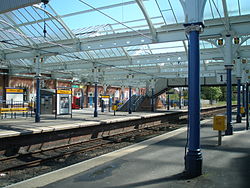Whitley Bay Metro station
| Whitley Bay | |
|---|---|
| Tyne and Wear Metro | |
|
|
|

View of the inside of the station, showing the platforms and canopy
|
|
| Location | |
| Place | Whitley Bay |
| Local authority | North Tyneside |
| WGS84 | 55°02′24″N 1°26′34″W / 55.0400°N 1.4427°WCoordinates: 55°02′24″N 1°26′34″W / 55.0400°N 1.4427°W |
| Fare zone information | |
| Network One zone | 3 |
| Metro zone | C |
| Original (1979) zone | 19 |
| Station code | WTL |
| History | |
| Opened | 3 July 1882 |
| Closed for conversion | 10 September 1979 |
| Metro since | 11 August 1980 |
| List of stations | |
Whitley Bay Metro station is a station on the Yellow line of the Tyne and Wear Metro network, in Whitley Bay, North Tyneside. It is located in a residential area, a short walk from both the town centre and the beach which attracts many of its passengers.
In 1860 the Blyth and Tyne Railway opened its line from Tynemouth to Dairy House Junction, south of the Northumbrian village of Hartley. The original station serving the town was named Whitley, and was located around 600 metres west of the present station site. However, this was only open for four years, being closed in 1864 and replaced by a station to the north, adjacent to present day Monkseaton Metro station.
In 1882 the North Eastern Railway (NER) opened its coastal route from Tynemouth to Monkseaton, replacing the inland Blyth and Tyne route, and a new station designed by William Bell was opened the same year, also called Whitley ('Bay' being added to the station's name in 1899). From 1904 the station was served by the electric trains of the NER. The electric services became so popular with people living in Whitley Bay and travelling to Newcastle to work, and also with those visiting the town for a day out or a holiday, that a new station became a necessity. The new building opened on 9 October 1910. Architectural historian Nikolaus Pevsner later said of the building that it "(lends) some distinction to an undistinguished neighbourhood"
The "Tyneside Electrics" were withdrawn by British Rail in 1967 and replaced by diesel multiple unit trains. The diesel trains provided a slower service, and trains called at intervals of every 30 minutes instead of every 20, although a limited-stop express service also called every hour.
In preparation for its second conversion to electric train operation, this time to join the Tyne and Wear Metro system, the station lost its services to Newcastle via Monkseaton on 23 January 1978, and was closed completely on 10 September 1979. It reopened on 11 August 1980, the first day of Metro service. The main changes involved in the station's conversion were shortening of the train shed at each end of the platforms and replacement of the original footbridge, with no further major changes having been made as of 2014. The station's main building and train shed were given Grade II listed building status in 1986.
...
Wikipedia
